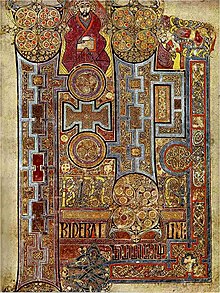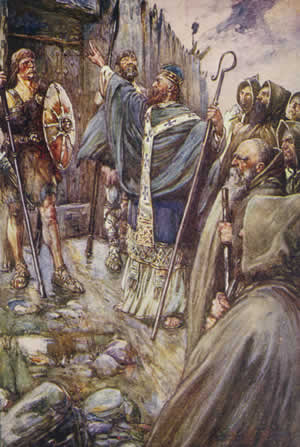
Columba or Colmcille was an Irish abbot and missionary evangelist credited with spreading Christianity in what is today Scotland at the start of the Hiberno-Scottish mission. He founded the important abbey on Iona, which became a dominant religious and political institution in the region for centuries. He is the patron saint of Derry. He was highly regarded by both the Gaels of Dál Riata and the Picts, and is remembered today as a Catholic saint and one of the Twelve Apostles of Ireland.
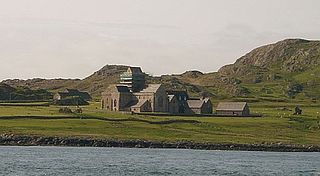
Iona is an island in the Inner Hebrides, off the Ross of Mull on the western coast of Scotland. It is mainly known for Iona Abbey, though there are other buildings on the island. Iona Abbey was a centre of Gaelic monasticism for three centuries and is today known for its relative tranquility and natural environment. It is a tourist destination and a place for spiritual retreats. Its modern Scottish Gaelic name means "Iona of (Saint) Columba".

The Book of Kells is an illuminated manuscript and Celtic Gospel book in Latin, containing the four Gospels of the New Testament together with various prefatory texts and tables. It was created in a Columban monastery in either Ireland or Scotland, and may have had contributions from various Columban institutions from each of these areas. It is believed to have been created c. 800 AD. The text of the Gospels is largely drawn from the Vulgate, although it also includes several passages drawn from the earlier versions of the Bible known as the Vetus Latina. It is regarded as a masterwork of Western calligraphy and the pinnacle of Insular illumination. The manuscript takes its name from the Abbey of Kells, County Meath, which was its home for centuries.
The Culdees were members of ascetic Christian monastic and eremitical communities of Ireland, Scotland, Wales and England in the Middle Ages. Appearing first in Ireland and then in Scotland, subsequently attached to cathedral or collegiate churches; they lived in monastic fashion though not taking monastic vows.

Kells is a town in County Meath, Ireland. The town lies off the M3 motorway, 16 km (10 mi) from Navan and 65 km (40 mi) from Dublin. Along with other towns in County Meath, it is within the commuter belt for Dublin, and had a population of 6,608 as of the 2022 census. It is best known as the site of Kells Abbey, from which the Book of Kells takes its name.
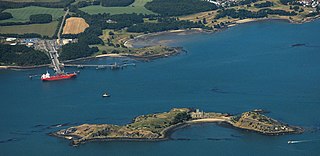
Inchcolm is an island in the Firth of Forth in Scotland. It was repeatedly attacked by English raiders during the Wars of Scottish Independence, and was fortified during both World Wars to defend nearby Edinburgh. Inchcolm now attracts visitors to its former Augustine Abbey.

The Abbey of Kells is a former monastery in Kells, County Meath, Ireland, 59 kilometres (37 mi) north-west of Dublin. It was founded in the early 9th century, and the Book of Kells was kept there during the later medieval and early modern periods before finally leaving the abbey in the 1650s. Much of the Book of Kells may have been created there, but historians cannot be certain of the exact date and circumstances of its creation.
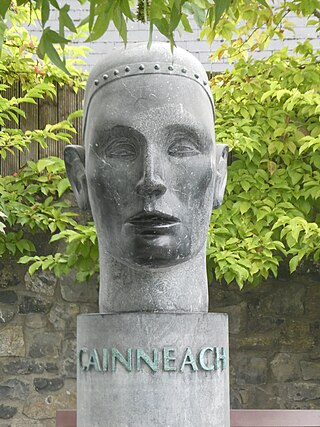
Cainnech of Aghaboe (515/16–600), also known as Saint Canice in Ireland, Saint Kenneth in Scotland, Saint Kenny and in Latin Sanctus Canicus, was an Irish abbot, monastic founder, priest and missionary during the early medieval period. Cainnech is one of the Twelve Apostles of Ireland and preached Christianity across Ireland and to the Picts in Scotland. He wrote a commentary on the Gospels, which for centuries was known as the Glas-Choinnigh or Kenneth's Lock or the Chain of Cainnech.
Brehon is a term for a historical arbitration, mediative and judicial role in Gaelic culture. Brehons were part of the system of Early Irish law, which was also simply called "Brehon law". Brehons were judges, close in importance to the chiefs.
A coarb, from the Old Irish comarbae, meaning "heir" or "successor", was a distinctive office of the medieval Celtic Church among the Gaels of Ireland and Scotland. In this period coarb appears interchangeable with "erenach", denoting the episcopally nominated lay guardian of a parish church and headman of the family in hereditary occupation of church lands. The coarb, however, often had charge of a church which had held comparatively high rank in pre‐Norman Ireland, or one still possessed of relatively extensive termon lands.

The Hiberno-Scottish mission was a series of expeditions in the 6th and 7th centuries by Gaelic missionaries originating from Ireland that spread Celtic Christianity in Scotland, Wales, England and Merovingian France. Celtic Christianity spread first within Ireland. Since the 8th and 9th centuries, these early missions were called 'Celtic Christianity'.
Adomnán or Adamnán of Iona, also known as Eunan, was an abbot of Iona Abbey (r. 679–704), hagiographer, statesman, canon jurist, and saint. He was the author of the Life of Columba, probably written between 697 and 700. This biography is by far the most important surviving work written in early-medieval Scotland, and is a vital source for our knowledge of the Picts, and an insight into the life of Iona and the early-medieval Gaelic monk.

The Abbot of Iona was the head of Iona Abbey during the Middle Ages and the leader of the monastic community of Iona, as well as the overlord of scores of monasteries in both Scotland and Ireland, including Durrow, Kells and, until the Synod of Whitby, Lindisfarne. It was one of the most prestigious clerical positions in Dark Age Europe, and was visited by kings and bishops of the Picts, Franks and English. The Ionan abbots also had the status of Comarba of Colum Cille, i.e. the successors of that Saint, Columba.
Christianity in medieval Scotland includes all aspects of Christianity in the modern borders of Scotland in the Middle Ages. Christianity was probably introduced to what is now Lowland Scotland by Roman soldiers stationed in the north of the province of Britannia. After the collapse of Roman authority in the fifth century, Christianity is presumed to have survived among the British enclaves in the south of what is now Scotland, but retreated as the pagan Anglo-Saxons advanced. Scotland was largely converted by Irish missions associated with figures such as St Columba, from the fifth to the seventh centuries. These missions founded monastic institutions and collegiate churches that served large areas. Scholars have identified a distinctive form of Celtic Christianity, in which abbots were more significant than bishops, attitudes to clerical celibacy were more relaxed and there were significant differences in practice with Roman Christianity, particularly the form of tonsure and the method of calculating Easter, although most of these issues had been resolved by the mid-seventh century. After the reconversion of Scandinavian Scotland in the tenth century, Christianity under papal authority was the dominant religion of the kingdom.
There is archaeological evidence of insular monasticism as early as the mid 5th century, influenced by establishments in Gaul such as the monastery of Martin of Tours at Marmoutier, the abbey established by Honoratus at Lérins; the abbey of Mont-Saint-Michel; and that of Germanus at Auxerre. Many Irish monks studied at Candida Casa near Whithorn in what is now Galloway in Scotland.
The Outer Hebrides are a unique religious area in contemporary Scotland. The northern island is dominated by Calvinist 'free churches', and has been described as "the last bastion of Sabbath observance in the UK". It is also home to a unique form of Gaelic psalm singing known as precenting. The southern islands of South Uist and Barra are the last remnants of native pre-Reformation Scottish Catholicism. Barra was once dubbed "the island the Reformation did not reach".

The Christianisation of Scotland was the process by which Christianity spread in what is now Scotland, which took place principally between the fifth and tenth centuries.
The battle of Cúl Dreimhne took place in the 6th century in the túath of Cairbre Drom Cliabh in northwest Ireland. The exact date for the battle varies from 555 AD to 561 AD. 560 AD is regarded as the most likely by modern scholars. The battle is notable for being possibly one of the earliest conflicts over copyright in the world.

Insular illumination refers to the production of illuminated manuscripts in the monasteries of Ireland and Great Britain between the 6th and 9th centuries, as well as in monasteries under their influence on continental Europe. It is characterised by decoration strongly influenced by metalwork, the constant use of interlacing, and the importance assigned to calligraphy. The most celebrated books of this sort are largely gospel books. Around sixty manuscripts are known from this period.
The martyrs of Iona were a group of 68 Celtic Christian monks who lived at Iona Abbey and were massacred there in the early ninth century. Viking raids of the British and Irish coasts began in 793 AD, when the Vikings conducted a bloody attack on the monastery of Lindisfarne on the English coast; so began the Viking Age of conquest. Iona itself suffered numerous attacks, starting in 795 AD and continuing in 802, 806, and 825. The massacre of the martyrs of Iona was the result of the raid of 806 AD, where fleets of Vikings stormed the abbey, pillaged it for riches, and killed the monks, who were largely without weapons, and thus defenseless. This was Iona's first incidence of "red martyrdom," or the bestowing of martyrdom as a result of violent death by religious persecution.




